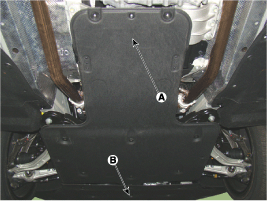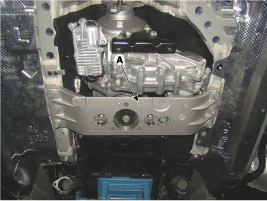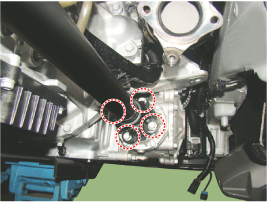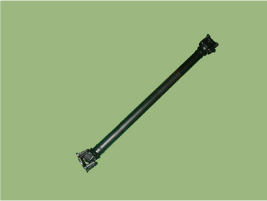Hyundai Genesis: Front Propeller Shaft Assembly / Front Propeller Shaft Repair procedures
Hyundai Genesis (DH) 2013-2016 Service Manual / Driveshaft and axle / Front Propeller Shaft Assembly / Front Propeller Shaft Repair procedures
| Removal |
| 1. |
Loosen the wheel nuts slightly. Raise the vehicle, and make sure it is securely supported. |
| 2. |
Remove the front wheel and tire (A) from the front hub.
|
| 3. |
Remove the under cover (A) & (B).
|
| 4. |
Remove the cross member (A) by removing bolts.
|
| 5. |
Remove the front propeller shaft by loosening bolts. [Both side]
|
| 6. |
Install in the reverse order of removal. |
 Front Propeller Shaft Components and Components Location
Front Propeller Shaft Components and Components Location
Components Location
1. Front propeller shaft2. Transfer case3.Front differential assembly
...
 Propeller Shaft Components and Components Location
Propeller Shaft Components and Components Location
Components Location
1. Propeller shaft2. Center bearing bracket
...
Other information:
Hyundai Genesis (DH) 2013-2016 Service Manual: Damper Clutch Control Solenoid Valve Specifications
Specifications Damper Clutch Control VFS ? Control type : Normal low type Control Pressure kpa (kgf/cm?, psi)0~500.14 (0~5.1,0~72.54)Current value(mA)0~850 Internal resistance(?)4.8~5.4 ...
Hyundai Genesis (DH) 2013-2016 Service Manual: Specifications
Specifications ItemSpecificationsTransmission typeA8LR1Engine modelGasoline 3.8GDI (SBC)Torque converter type3-element, 1-stage, 2-phase typeOil pump systemInternal gear typeFriction elementsClutch: 4EABrake: 2EAOWC : 1EAPlanetary gear 3EAGear ratio1st3.6652nd2.3963rd1.6104th1.1905th1.0006 ...
© 2013-2025 www.hgenesisdh.com







